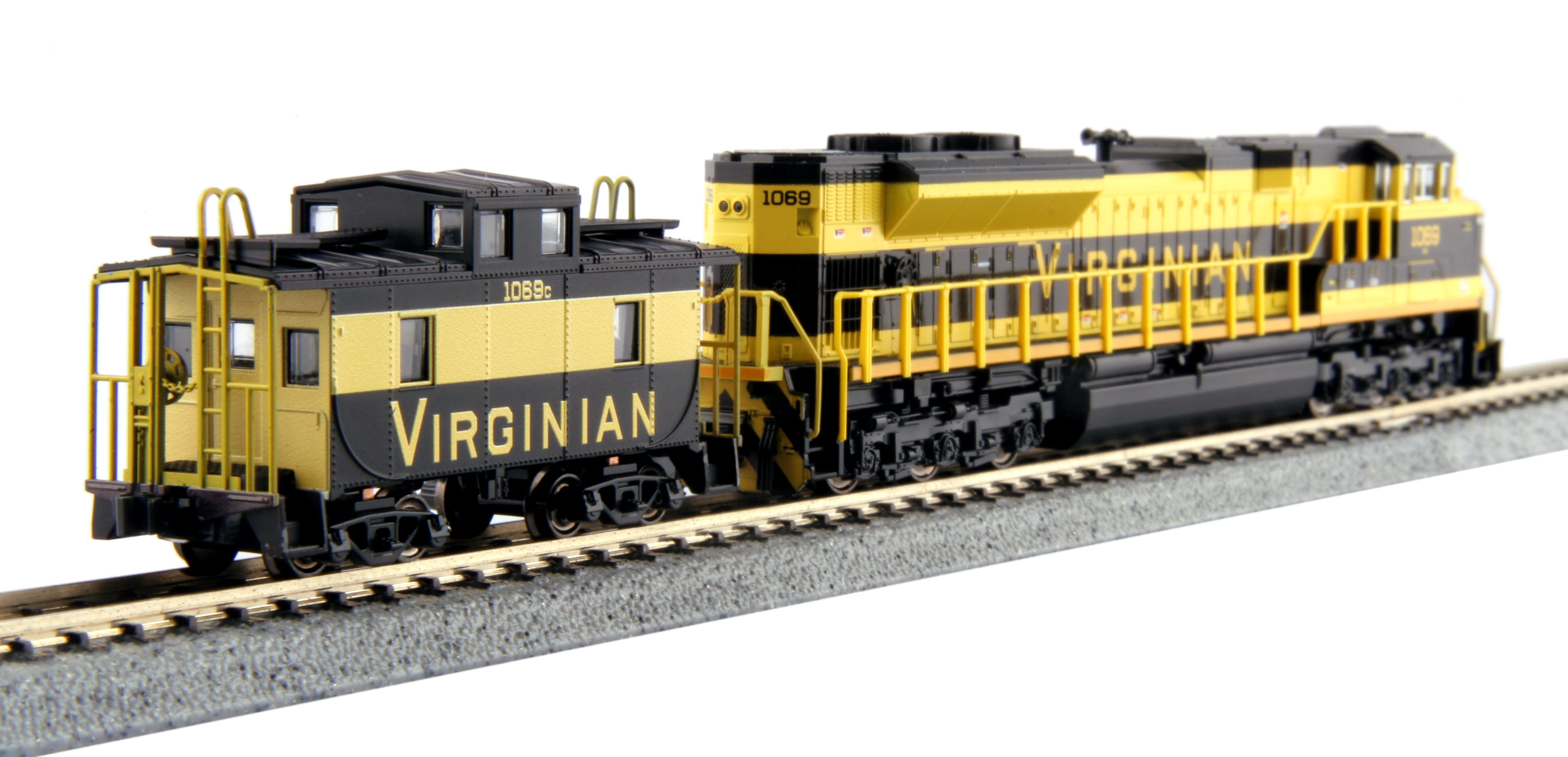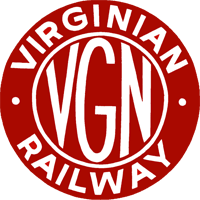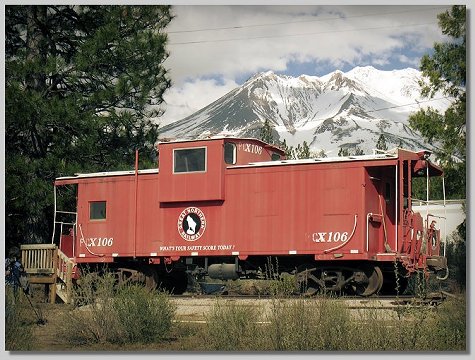Model Information: Kato designed this tooling to model the Morrison International modular caboose. It features metal wheels and body-mount couplers.
These models have very nice detail on the roof walkway, the end platforms and railings, and the truck sideframes.
The also feature free and smooth rolling trucks for maximum performance.
Prototype History: This caboose was designed by the Morrison International shop in Kenton, Ohio. Because of the great variety of equipment needs between railroads in the 1950's, International developed the idea of a "modular" caboose design. This conceptual design essentially broke the caboose down on paper into different types or styles that could be built to meet the specific needs of a particular railroad. Rather than trying to force a rigid, fixed design on all the railroads, International felt it better to let the railroad select the pieces to build the caboose to their own liking.
Road Name History: The Virginian Railway (VGN) was conceived early in the 20th century by two men. One was a brilliant civil engineer, coal mining manager, and entrepreneur, William Nelson Page. His partner was millionaire industrialist, Henry Huttleston Rogers. Together, they built a well-engineered railroad that was virtually a "conveyor belt on rails" to transport high quality "smokeless" bituminous coal from southern West Virginia to port on Hampton Roads, near Norfolk, Virginia.
The Virginian Railway Company was formed in Virginia on March 8, 1907 to combine the Deepwater Railway in West Virginia and the Tidewater Railway in Virginia into a single interstate railroad, only a few months after Victoria was incorporated. On April 15, 1907, William Nelson Page became the first president of the new Virginian Railway.
Throughout that profitable 50-year history, the VGN continued to follow the Page-Rogers policy of "paying up front for the best." It became particularly well known for treating its employees and vendors well, another investment that paid rich dividends. The VGN sought (and achieved) best efficiencies in the mountains, rolling piedmont and flat tidewater terrain. The profitable VGN experimented with the finest and largest steam, electric, and diesel locomotives. It was well known for operating the largest and best equipment, and could afford to. It became nicknamed "the richest little railroad in the world."
Norfolk & Western Railway and Virginian Railway merged in 1959.
The Virginian Railway Company was formed in Virginia on March 8, 1907 to combine the Deepwater Railway in West Virginia and the Tidewater Railway in Virginia into a single interstate railroad, only a few months after Victoria was incorporated. On April 15, 1907, William Nelson Page became the first president of the new Virginian Railway.
Throughout that profitable 50-year history, the VGN continued to follow the Page-Rogers policy of "paying up front for the best." It became particularly well known for treating its employees and vendors well, another investment that paid rich dividends. The VGN sought (and achieved) best efficiencies in the mountains, rolling piedmont and flat tidewater terrain. The profitable VGN experimented with the finest and largest steam, electric, and diesel locomotives. It was well known for operating the largest and best equipment, and could afford to. It became nicknamed "the richest little railroad in the world."
Norfolk & Western Railway and Virginian Railway merged in 1959.
Brand/Importer Information: KATO U.S.A. was established in 1986, with the first U.S. locomotive model (the GP38-2, in N-Scale) released in 1987. Since that time, KATO has come to be known as one of the leading manufacturers of precision railroad products for the modeling community. KATO's parent company, Sekisui Kinzoku Co., Ltd., is headquartered in Tokyo, Japan.
In addition to producing ready-to-run HO and N scale models that are universally hailed for their high level of detail, craftsmanship and operation, KATO also manufactures UNITRACK. UNITRACK is the finest rail & roadbed modular track system available to modelers today. With the track and roadbed integrated into a single piece, UNITRACK features a nickel-silver rail and a realistic-looking roadbed. Patented UNIJOINERS allow sections to be snapped together quickly and securely, time after time if necessary.
The Kato U.S.A. office and warehouse facility is located in Schaumburg, Illinois, approximately 30 miles northwest of Chicago. All research & development of new North American products is performed here, in addition to the sales and distribution of merchandise to a vast network of wholesale representatives and retail dealers. Models requiring service sent in by hobbyists are usually attended to at this location as well. The manufacturing of all KATO products is performed in Japan.
Supporters of KATO should note that there is currently no showroom or operating exhibit of models at the Schaumburg facility. Furthermore, model parts are the only merchandise sold directly to consumers. (Please view the Parts Catalog of this website for more specific information.)
In addition to producing ready-to-run HO and N scale models that are universally hailed for their high level of detail, craftsmanship and operation, KATO also manufactures UNITRACK. UNITRACK is the finest rail & roadbed modular track system available to modelers today. With the track and roadbed integrated into a single piece, UNITRACK features a nickel-silver rail and a realistic-looking roadbed. Patented UNIJOINERS allow sections to be snapped together quickly and securely, time after time if necessary.
The Kato U.S.A. office and warehouse facility is located in Schaumburg, Illinois, approximately 30 miles northwest of Chicago. All research & development of new North American products is performed here, in addition to the sales and distribution of merchandise to a vast network of wholesale representatives and retail dealers. Models requiring service sent in by hobbyists are usually attended to at this location as well. The manufacturing of all KATO products is performed in Japan.
Supporters of KATO should note that there is currently no showroom or operating exhibit of models at the Schaumburg facility. Furthermore, model parts are the only merchandise sold directly to consumers. (Please view the Parts Catalog of this website for more specific information.)
Commissioner Information: Kobo Customs is Kato's department in charge of custom models
Item created by: CNW400 on 2020-10-06 23:16:56. Last edited by Alain LM on 2020-12-04 07:03:55
If you see errors or missing data in this entry, please feel free to log in and edit it. Anyone with a Gmail account can log in instantly.
If you see errors or missing data in this entry, please feel free to log in and edit it. Anyone with a Gmail account can log in instantly.










